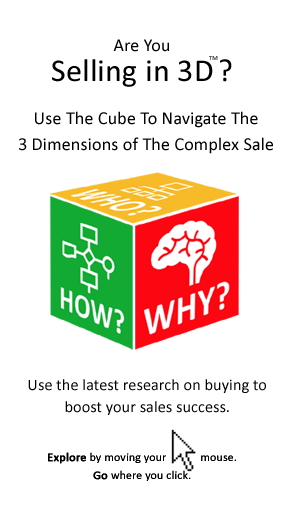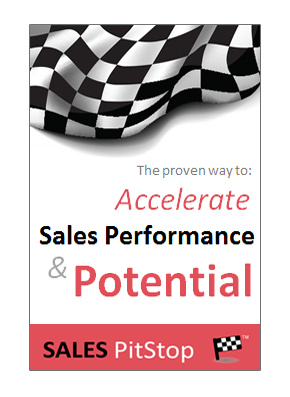How to Maximise the Success of Your Sales Calls
In the present environment, salespeople are delighted with the opportunity to meet with anybody who expresses an interest. But, what exactly is the purpose of that first meeting and how to maximise its success? For example, how speedily can you qualify the opportunity?

To help you we have pulled some of the key points from Miller Heiman’s NEW CONCEPTUAL SELLING which in the words of the authors describes ‘the most effective and proven method for face to face sales planning’. And it is a refreshing read, bring us back to the basics, that are so easily overlooked in the complex sale.
The purpose of this book is clear. It is spelt out in the opening sentence of Chapter One: ‘This book shows you how to stop selling.’ So, you are immediately confused, just how is it going to help me as a salesperson then? Well, Miller Heiman want us to focus instead on how the customer buys and on making that easier. That means adopting what they call a partnership approach to mutually exploring needs and solutions with our customers.
Partners in Exploring Options
So, how to you begin this partnership process? Well, state it as your objective, for example starting your customer meeting with something like this: ‘I am really not try to ‘sell’ you anything. Instead, because we are not for everyone, I would like us together to explore whether or not we have a match here. I know exactly where we fit and where we don’t, so I would like to ask you as many questions as you would like to ask me… Is this ok with you?’ The end result a more relaxed buyer, as well as a more relaxed salesperson and a more effective process of interaction.
Note the salesperson is immediately suggesting a process of two way communication, or dialogue as the approach. They remind us what we all know, but can easily forget – that is ‘show and tell’ sessions are not effective. We need to have conversations instead. For too long salesperson have been telling customers what they need, but now those same customers have stopped listening, after all they have real business decisions to make.
Joint Venture Selling
The first step on the path to joint venture selling is to scrap the assumption that the prospect needs your solution and that by showing it he, or she will immediately recognize that need. Here is the fundamental point – ‘people buy for their own reasons not yours!’ In a similar vein, people don’t resist their own ideas, but will resist those foisted upon them.
So, the task of the salesperson is to understand his, or her needs and the decision making process by which they will be met.
Life beyond the product pitch.
Let us revisit selling complex solutions 101 – ‘nobody buys a product, or service per se. What is bought is what the customer thinks the product, or service will do for him, or her.’ This is encapsulated in what what the authors refer to as the customer’s own personal ‘solution concept’.
For example, two organisations may require a CRM system, but for totally different reasons. The salesperson who sells the same way to each, pitching their and highlighting its feature set, is missing the point. Each customer has a unique and individual concept of the solution for his, or her business. Knowing exactly what that is the vital first step to a sale.
‘Customerized Selling’
The salesperson’s job is not just discovering the customer’s solution concept, but helping shape it too. This process of adapting what you have got to the unique needs of each customer and the ideas that they want expressed, is what the authors call ‘customerized selling’. Key to this process is addressing the following questions:
Why am I here? This requires defining the sales objective for each meeting, or call. This goes hand in hand with effective sales meeting and sales call planning.
What do I want the customer to do? That is the ideal, or at least the minimum commitment that you expect from the customer as a next step following your meeting – after all it is a joint process, or no process at all. Before the meeting you will confirm with the prospect that this step is an appropriate next action, in this way ensuring agreement and commitment.
Ensure that people are with you on the journey – testing on an ongoing basis their level of interest, engagement and commitment. Measure the pulse of the relationship, as well as the opportunity, by regularly checking for commitment on the part of the customer.
If the customer does not take, or complete a specific next action following a meeting then perhaps he, or she does not clearly see a personal win and work in this area is required. Otherwise perhaps this is no win-win to be had at this time and you should look elsewhere.
Why should the customer see me? This relates to what the authors call a ‘valid business reason’ for the customer, or prospect to want to allocate time to meet with the salesperson. Clearly agreeing this in advance will warm up your call (if it is a cold call) and set expectations for the meeting, including who should be present and increase its effectiveness. If it is simply meeting a prospect for a sales call and there is no ‘valid business reason’ in the eyes of the prospect then it is not a sales call.
Do I have credibility? Before you prospect can talk about needs or explore your solution, he, or she had to be comfortable regarding your credibility, and that of your company. So, pay attention to the nature of the questions the prospect is asking, are they about your solution, or your credibility?
Present the prospect with evidence of your credibility which is based on your confidence, appearance and approach, as well as what you communicate about your experience, knowledge, associations, accreditations, etc.
What Information am I missing?

As salespeople we have the dominant gene for talking. However, we need to stop talking and start listening. To help us we need good questions that will fill in any gaps in the information that we have about our prospects and their needs, solution concept, buying process, etc.
It is important to prepare a list of the right questions and asking them in the right way, including how they are phrased and sequenced. Then afford silence to the answers. These questions are not just aimed at eliciting facts, but also building understanding and in particular exploring soft areas such as attitudes, emotions, culture, etc.
So, the sales person is no longer in control.
The salesperson has to let go of the notion of control. He, or she must stop assuming that the customer needs what he, or she has got and start listen intensively to what the customer actually wants. He, or she is no longer the ‘ring master at the sale’, to use the authors words, but merely a facilitator and communicator.
The salesperson’s new job is to get information, give information and build commitment through what the authors call a ‘joint venture’ approach to selling. And the founding principle of that approach is a win-win, where buyer and seller create the environment and conditions for a mutually beneficial relationship.
Arriving at a win-win situation.

Win-win is a genuine situation where neither the buyer,
or the seller seeks to steal a short term win over the other. For the seller this win-win mentality is key to ensuring repeat business and enthusiastic referrals for the customer. Something similar applies for the buyer, who does not foist unreasonable terms on the seller that would result in a one sided deal that would cut the cost of the solution, but might also impact on the suppliers ability, or commitment to deliver.
The win-win mentality is the ultimate expression of joint venture selling, with parity of needs and esteem. It means that the seller does not adopt a ‘cap in hand’ mentality and is prepared to walk away if the relationship cannot be mutually advantageous.
Praise for this book:
THE NEW CONCEPTUAL SELLING by Miller Heiman is not new, in fact it was first published as far back as 1987. However, it is still the gold standard as regards sales methodology for the complex sale. This book provides the fundamentals that will always be important, regardless of any trend, or fads in selling.
Related
John O' Gorman is a Business to Business sales coach, Director of The ASG Group and co-author of the ground-breaking book, The B2B Sales Revolution. John works with sales teams and sales managers across Europe to accelerate sales using the sales performance solution; SellerNAV.




































You must be logged in to post a comment Login